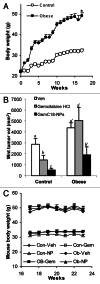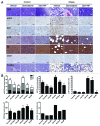Stearoyl gemcitabine nanoparticles overcome obesity-induced cancer cell resistance to gemcitabine in a mouse postmenopausal breast cancer model
- PMID: 23358472
- PMCID: PMC3667876
- DOI: 10.4161/cbt.23623
Stearoyl gemcitabine nanoparticles overcome obesity-induced cancer cell resistance to gemcitabine in a mouse postmenopausal breast cancer model
Abstract
Obesity is associated with increased breast tumor aggressiveness and decreased response to multiple modalities of therapy in postmenopausal women. Delivering cancer chemotherapeutic drugs using nanoparticles has evolved as a promising approach to improve the efficacy of anticancer agents. However, the application of nanoparticles in cancer chemotherapy in the context of obesity has not been studied before. The nucleoside analog gemcitabine is widely used in solid tumor therapy. Previously, we developed a novel stearoyl gemcitabine solid-lipid nanoparticle formulation (GemC18-NPs) and showed that the GemC18-NPs are significantly more effective than gemcitabine in controlling tumor growth in mouse models. In the present study, using ovariectomized diet-induced obese female C57BL/6 mice with orthotopically transplanted MMTV-Wnt-1 mammary tumors as a model of postmenopausal obesity and breast cancer, we discovered that obesity induces tumor cell resistance to gemcitabine. Furthermore, our GemC18-NPs can overcome the obesity-related resistance to gemcitabine chemotherapy. These findings have important clinical implications for cancer chemotherapies involving gemcitabine or other nucleoside analogs in the context of obesity.
Keywords: chemoresistance; nanoparticles; obesity; tumor.
Figures



References
Publication types
MeSH terms
Substances
Grants and funding
LinkOut - more resources
Full Text Sources
Other Literature Sources
Medical
